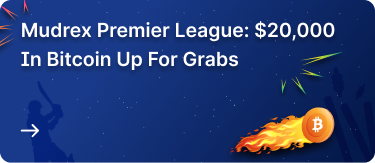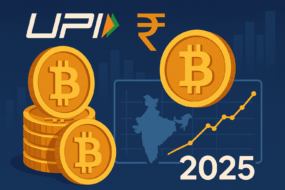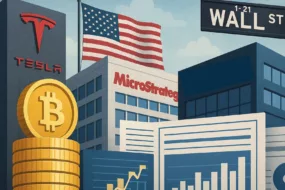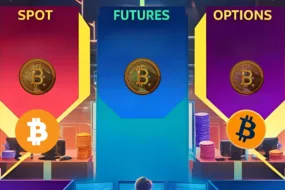
Trust and Security are Paramount in Finance. Traditional finance creates trust and security through third-party middlemen like banks and financial institutions. But this comes at the cost of high fees and limited access. What if there was another way to empower individuals, reduce costs, and enhance security?
This is where DeFi(Decentralised Finance) comes in. DeFi aims to create transparent, secure, and accessible financial systems without middlemen by leveraging blockchain technology and smart contracts.
In this blog, we’ll explore the fundamentals of DeFi, its benefits and risks, current and future use cases, and how you can get involved in this revolutionary financial movement.
DeFi: Meaning, Core Values, Goals
Decentralized Finance, or DeFi, is an umbrella term for financial services based on public blockchains.
The easiest way to imagine DeFi is as Banking Activity—lending, borrowing, earning interest, trading assets, insurance—done FASTER, without paperwork, without Middlemen, just using an Internet connection.
DeFi would let you do all those activities for which you depended on Banks, brokers, and insurance agents without middlemen and the costs they charged. The existence of Smart Contracts makes this possible. Smart Contracts are chunks of code that run on a Blockchain ledger. They can automate financial transactions and verify them.
To Simplify even further,
- DeFi is a new financial system built on a blockchain ledger.
- DeFi transacts in cryptocurrency.
- DeFi automates lending, borrowing, and trading via smart contracts, self-executing codes deployed on the blockchain.
What DeFi Aims to Achieve
The mission of DeFi is to revolutionize the traditional financial system by leveraging blockchain technology and smart contracts. Its core aim is to create a more open, transparent, and inclusive financial ecosystem that empowers individuals and reduces reliance on intermediaries like banks.
DeFi aims to achieve this by:
- Democratizing access: Providing financial services to anyone with an internet connection, regardless of location or background.
- Increasing transparency: Ensuring all transactions are recorded on a public blockchain, visible to everyone.
- Reducing costs: Eliminating intermediaries and their associated fees, making financial services more affordable.
- Enhancing security: Leveraging blockchain’s security features to protect users’ assets from fraud and theft.
- Fostering innovation: Enabling rapid development and deployment of new financial products and services through composability.
DeFi’s ultimate goal is to create a more equitable and efficient financial system that benefits everyone.
While still in its early stages, the potential impact of DeFi is undeniable, and it’s exciting to see how this technology will continue to evolve and disrupt the financial landscape.
Centralized Finance (CeFi) vs. Decentralized Finance (DeFi)
| Aspect | Centralized Finance (CeFi) | Decentralized Finance (DeFi) | How DeFi Differs from Traditional Financial Services |
| Control | Controlled by central authorities | No central authority; peer-to-peer | DeFi removes intermediaries, allowing direct transactions |
| Regulation | Heavily regulated by governments | Less regulated; governed by smart contracts | Traditional services are bound by regulatory bodies, while DeFi operates autonomously |
| Transparency | Limited transparency | High transparency via blockchain | DeFi provides open access to transaction details |
| Accessibility | Access is restricted by geographical and financial barriers | Open to anyone with internet access | DeFi is borderless and inclusive compared to traditional systems |
| Security | Dependent on centralized security measures | Decentralized security via cryptography | DeFi’s security is spread across the network, reducing single points of failure |
| Intermediaries | Banks, brokers, and other institutions | No intermediaries; automated by smart contracts | Traditional services rely on intermediaries, while DeFi automates transactions |
| Transaction Speed | Often slower due to intermediary processes | Faster due to direct transactions | DeFi enables near-instant transactions compared to traditional delays |
| Fees | Typically higher due to intermediary fees | Generally lower fees | DeFi reduces costs by eliminating intermediary fees |
| Custody of Funds | Held by financial institutions | Users hold their own funds | DeFi allows users full control over their assets |
| Innovation | Slower to innovate due to regulatory constraints | Rapid innovation due to open-source nature | DeFi’s open-source ecosystem encourages continuous innovation |
ALSO READ: CEX VS DEX: 6 Key Differences Between CEX & DEX
Key characteristics of DeFi applications
1. Decentralized: Unlike traditional finance, DeFi applications operate on decentralized blockchain networks, eliminating the need for intermediaries like banks or brokers. This decentralization means no single entity controls the system, making it more resistant to censorship, manipulation, or single points of failure.
2. Open & Permissionless: DeFi applications are open to anyone with an internet connection and a crypto wallet. There are no restrictions based on location, credit score, or other traditional barriers to entry. Users can interact with DeFi platforms directly without needing permission from a central authority.
3. Transparent: All transactions on DeFi platforms are recorded on a public blockchain, visible to anyone. This transparency promotes accountability and trust, as users can verify the accuracy and legitimacy of transactions.
4. User-centric: DeFi applications prioritize user control and ownership. Users have full custody of their assets and can interact directly with smart contracts without relying on intermediaries. This allows users to make their own financial decisions and manage their assets according to their own preferences.
5. Interoperable: DeFi applications are designed to work together seamlessly, thanks to standardized protocols and interfaces. This interoperability enables users to move their assets and data between different platforms effortlessly, creating a more interconnected and efficient financial ecosystem.
6. Composable: DeFi applications are built with modularity and composability in mind, allowing developers to combine and integrate different components to create new and innovative financial products and services. This composability accelerates innovation and allows for the rapid development of complex financial instruments.
ALSO READ: Which Are The Top 10 Decentralized Exchanges?
Benefits of DeFi
DeFi is reshaping finance with its user-centric advantages:
- Accessible: Unlike traditional banks with limited hours and locations, DeFi platforms are available 24/7 to anyone with internet access. This inclusivity opens up financial opportunities for the unbanked and underbanked populations worldwide.
- Private: DeFi transactions occur directly between users through pseudonymous addresses, safeguarding personal information and enhancing privacy compared to traditional systems requiring extensive personal data.
- Fast: DeFi transactions are processed rapidly on the blockchain, eliminating delays caused by intermediaries. This speed is crucial for time-sensitive transactions and global transfers.
- Security & Transparency: Blockchain’s immutable ledger ensures the transparency and security of every transaction. Smart contracts automate processes, minimizing human error and reducing the risk of fraud compared to traditional systems.
Challenges and Risks of DeFi
Despite its revolutionary potential, DeFi has its own challenges and risks, demanding careful navigation and due diligence from participants.
- Trust: The decentralized nature of DeFi eliminates traditional intermediaries, shifting the burden of trust onto smart contracts and code. Security audits and thorough due diligence are crucial to mitigate the risk of scams and rug pulls.
- Fluctuating Rates: The value of cryptocurrencies used in DeFi can be highly volatile, leading to potential losses if not managed carefully. Users must be prepared for price swings and consider stablecoins or hedging strategies.
- Volatility: DeFi markets can be highly volatile, with rapid price changes and significant liquidity risks. This volatility can amplify losses and make it difficult for users to accurately assess the value of their investments.
- Errors and Hacking: Smart contract vulnerabilities can be exploited by malicious actors, leading to significant financial losses. Regular audits and robust security practices are essential to safeguard user funds.
- Regulation: The regulatory landscape for DeFi is still evolving, creating uncertainty and potential compliance risks for users and platforms. Staying informed about regulatory developments is crucial for navigating this evolving space.
Current and Future Use Cases of DeFi
DeFi offers a wide array of use cases that challenge traditional systems. Here are some of the most prominent ones:
- Trading: DeFi enables trustless, peer-to-peer trading of cryptocurrencies and other digital assets without the need for intermediaries.
- Lending and Borrowing: Platforms like Aave and Compound allow users to lend or borrow cryptocurrencies, earning interest or paying interest respectively, without the involvement of traditional financial institutions.
- Stablecoins: These are cryptocurrencies pegged to the value of fiat currencies or other assets, providing a stable store of value within the volatile crypto market.
- Decentralized Exchanges (DEXs): Unlike centralized exchanges, DEXs like Uniswap and SushiSwap facilitate trustless trading without custodial ownership of users’ funds.
- Yield Farming: Users can provide liquidity to DeFi protocols and earn rewards in the form of governance tokens or transaction fees.
- Synthetic Assets: These are tokenized derivatives that track the value of real-world assets, such as stocks, commodities, or even entire indices.
- DeFi Insurance: Protocols like Nexus Mutual offer insurance coverage against various risks in the DeFi ecosystem, such as smart contract failures or hacks.
- Prediction Markets: Platforms like Augur and Polymarket enable users to speculate on the outcome of future events by trading prediction tokens.
As DeFi continues to evolve, new use cases are expected to emerge, including decentralized identity management, governance mechanisms, and asset tokenization, further transforming the financial landscape.
Practical examples of DeFi applications
DeFi’s transformative power is best understood through real-world applications, showcasing how decentralized protocols revolutionize financial services.
What is a DApp?
Dapps or Decentralised Apps run on a decentralized network like a blockchain. They interact with smart contracts and leverage the benefits of decentralization, such as transparency, security, and immutability.
ALSO READ: What Is Ethereum Explained With How It Works & Its Purpose
1. Aave
Aave is a decentralized finance (DeFi) lending protocol allowing users to borrow cryptocurrencies. It was founded by Stani Kulechov in November 2017 and originally named ETHLend. In 2020, ETHLend was rebranded as Aave, which means “ghost” in Finnish. Aave raised $16.2 million through an initial coin offering (ICO) in 2017, selling 1 billion LEND tokens.
2. Synthetix (previously known as Havven)
Synthetix is a decentralized finance (DeFi) protocol that enables the issuance of synthetic assets called Synths. It was founded in 2018 by Kain Warwick and the Havven team. The project was initially called Havven but was rebranded to Synthetix in 2019.
3. REN (previously Republic Protocol)
REN is an open protocol that enables the permissionless transfer of value between blockchains. It was founded in 2017 by Taiyang Zhang, Loong Wang, and the Republic Protocol team.The project was initially called Republic Protocol but was rebranded to REN in 2019.
4. Kyber Network
Kyber Network is a decentralized exchange (DEX) and liquidity protocol that allows for the exchange of cryptocurrencies. It was founded in 2017 by Loi Luu, Victor Tran, Yaron Velner, and the Kyber Network team.
5. 0x
0x is an open protocol that facilitates the peer-to-peer exchange of Ethereum-based assets. It was founded in 2016 by Will Warren and Amir Bandeali.
ALSO READ: Explore DEFI 2.0 tokens and their market data
How to Get Started with DeFi
If DeFi has caught your attention and you want to get started with it, here’s how:
- Get a Crypto Wallet: The first step is to set up a digital wallet compatible with DeFi platforms. Popular options include MetaMask, Trust Wallet, or Coinbase Wallet. This will be your gateway to interacting with DeFi apps and storing your assets securely.
- Acquire Cryptocurrency: Next, you’ll need to acquire some cryptocurrency to use on DeFi platforms. You can purchase popular cryptocurrencies like Ethereum (ETH) or stablecoins like USD Coin (USDC) on centralized exchanges like Coinbase or Binance.
- Choose a DeFi Platform: Explore different DeFi platforms and choose one that aligns with your interests and goals. Popular options include Aave for lending and borrowing, Uniswap or SushiSwap for trading, and Curve Finance for stablecoin swaps.
- Connect Your Wallet: Once you’ve selected a platform, connect your wallet to it. This will allow you to interact with the platform’s features and access your funds.
- Start Exploring: Begin by trying basic functions like swapping tokens or depositing funds into a lending pool. As you gain confidence, you can explore more advanced features like yield farming or synthetic assets.
ALSO READ: What Are DeFi Tokens, And Why Are They Growing
TVL: The Pulse of the DeFi Ecosystem
Total Value Locked (TVL) is a key metric in the DeFi landscape. It represents the total value of crypto assets deposited or “locked” within a specific DeFi protocol or across the entire ecosystem. Essentially, it measures the amount of money users have entrusted to DeFi platforms in US Dollars.
TVL serves as a barometer of DeFi’s popularity and growth, reflecting investor confidence and the ecosystem’s overall health. A higher TVL indicates greater liquidity, attracting more users and driving further growth.
Investors and analysts often use TVL to compare different DeFi protocols, assess their market share, and evaluate their potential for generating returns.
However, it’s important to note that TVL alone doesn’t provide a complete picture of a protocol’s health or potential risks. Other factors like security, user experience, and project fundamentals should also be considered.
ALSO READ: How To Invest In DeFi?
Conclusion
DeFi is revolutionizing traditional finance with its decentralized and transparent approach. With the power of blockchain technology, DeFi empowers individuals, breaks down barriers, and fosters financial inclusion on a global scale.
As this innovative ecosystem grows, it paves the way for a more equitable and accessible future where anyone can participate and benefit from secure, cost-effective financial services. Embrace the opportunities DeFi presents, and be part of the movement reshaping the world’s financial landscape for the better.
FAQs
1. What is DeFi (decentralized finance) explained?
DeFi, short for decentralized finance, is a revolutionary financial system built on blockchain technology. It aims to recreate traditional financial services, like lending, borrowing, and trading, without the need for intermediaries like banks or brokers. Instead, DeFi platforms use smart contracts—self-executing code on the blockchain—to automate these services, making them more accessible, transparent, and efficient.
2. What is the DeFi model of finance?
The DeFi model is a peer-to-peer (P2P) financial system where users interact directly with each other through smart contracts. This eliminates the need for intermediaries, reduces costs, and increases accessibility. DeFi platforms offer various financial services, including lending and borrowing, decentralized exchanges (DEXs), yield farming, stablecoins, and more.
3. Where can DeFi be used?
DeFi applications can be accessed from anywhere worldwide with an internet connection. You can use DeFi platforms to lend or borrow cryptocurrencies, trade on decentralized exchanges, earn interest through yield farming, and even participate in decentralized autonomous organizations (DAOs). Be sure to check out the “Getting Started with DeFi” section of our blog for a step-by-step guide on accessing and using DeFi platforms.
4. What are the core concepts of DeFi?
Here are some of the core concepts of DeFi
- Smart Contracts: Self-executing code that automates financial agreements.
- Decentralization: No central authority controls the system.
- Transparency: All transactions are recorded on the blockchain and publicly verifiable.
- Open Source: Most DeFi protocols are open source, allowing anyone to contribute and audit the code.
- Composability: DeFi applications can be easily combined and integrated to create new financial products.





